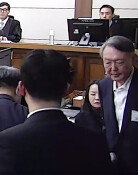U.S. to expand training for extended deterrence against N. Korea
U.S. to expand training for extended deterrence against N. Korea
Posted February. 11, 2023 07:14,
Updated February. 11, 2023 07:14
The U.S. Department of State stated on Thursday that they would enhance the frequency and strength of deployment of U.S. strategic assets and expand training for extended deterrence in response to North Korea's new intercontinental ballistic missile (ICBM) believed to be powered by a solid fuel engine unveiled during a military parade.
In response to an inquiry from The Dong-A Ilbo about North Korea’s military parade held on Wednesday, the U.S. State Department spokesperson's office emphasized that South Korea and the U.S. will continue to work together to fortify extended deterrence in the face of North Korea's escalating political rhetoric about their nuclear weapons program. It emphasized that the Yoon Suk Yeol administration has clearly stated its commitment not to pursue nuclear weapons and will closely collaborate with the U.S. through the existing extended deterrence system. It also pointed out that North Korea pursued illegal nuclear weapons and elevated tension on the Korean Peninsula.
The department clearly stated that North Korea was accountable for elevating tensions on the Korean Peninsula by emphasizing South Korea’s commitment not to develop its own nuclear program. Meanwhile, North Korea unveiled its new ICBM and tactical nuclear operation unit, which it described as a "display of maximum nuclear attack capability." It is interpreted as a warning message, and a response came out of a concern that public opinion on developing nuclear weapons could escalate in South Korea.
At a briefing on the same day, State Department spokesman Ned Price said, “We would like to see the DPRK cease these provocations. We would like to see the DPRK engage in dialogue. But until and unless that happens, our approach will remain the same.” It means that the U.S. will pursue a dual approach of advocating for stronger sanctions against the country while also considering military options, such as strengthening extended deterrence if the North does not stop its provocations.
Ankit Panda, a senior researcher at the Carnegie Endowment for International Peace, informed Radio Free Asia (RFA) that the new weapon showcased at the North Korean military parade is believed to be a solid fuel-powered ICBM, and the country will test-launch solid-fuel ICBM within months.
Ian Williams, a researcher at the Center for Strategic and International Studies (CSIS), said, “The preparation time for launch is much shorter” for solid fuel ICBMs, and “It is also difficult to attack the ‘left side of the launch (before launch)’ stage, which destroys the missile before launch.” Former White House weapons of mass destruction coordinator Gary Seymour also said in the CSIS interview that he was “not optimistic” about North Korea’s missile defense through missile defense systems such as the Iron Dome.
weappon@donga.com






![“설거지해도 그대로”…냄비 ‘무지개 얼룩’ 5분 해결법 [알쓸톡]](https://dimg.donga.com/c/138/175/90/1/wps/NEWS/IMAGE/2026/01/15/133164664.3.png)
